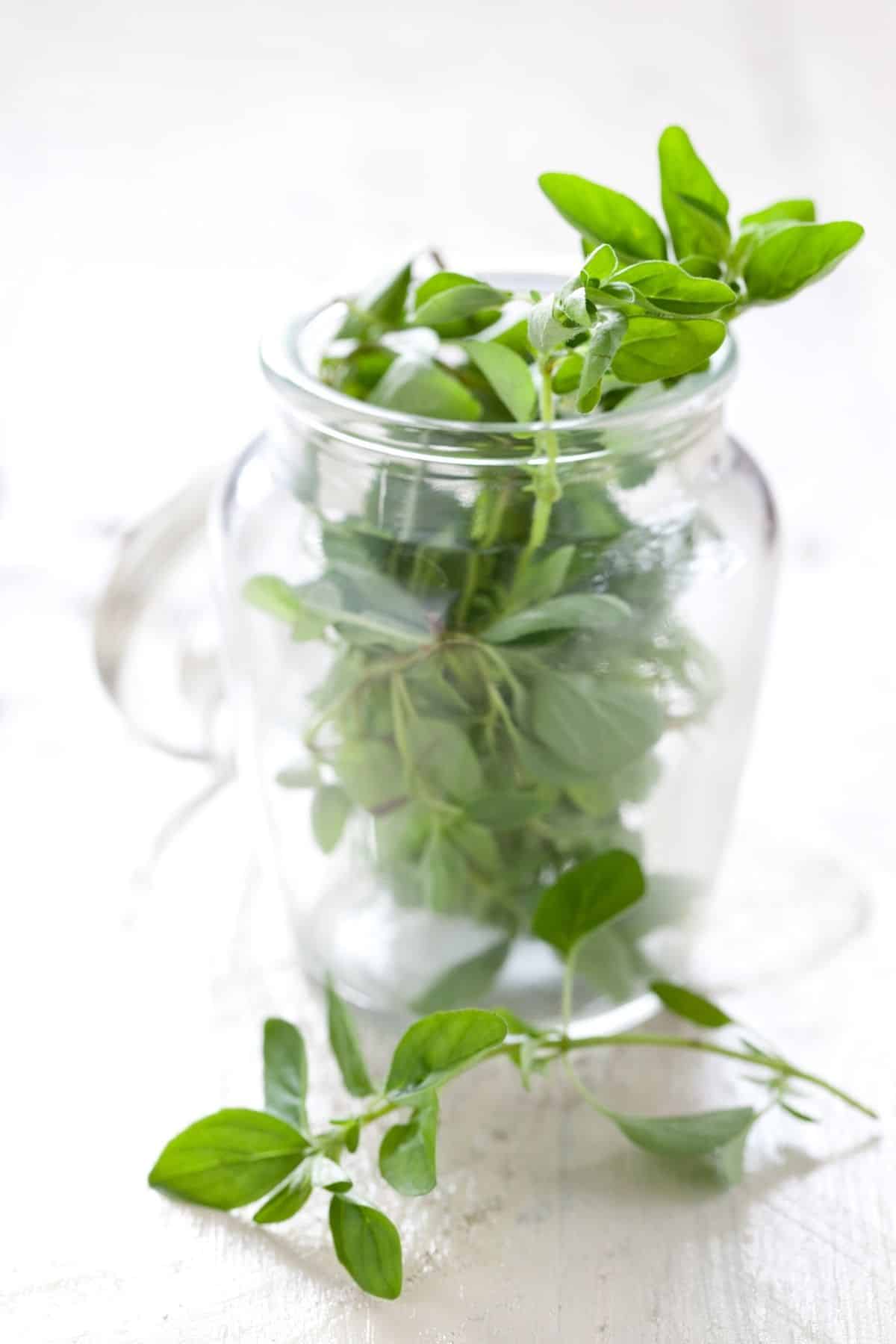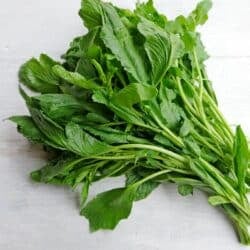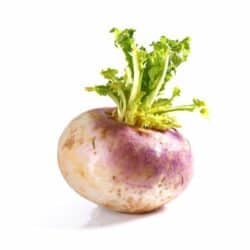5 Simple Substitutes for Marjoram (& How Much to Use)
Marjoram is a flavorful seasoning used in many dishes. But, don’t worry if you don’t have it in your kitchen. This article reviews several simple substitutes for marjoram that are easy to find. I’ve also included specific measurements for how much to use of each alternative.

Overview of Marjoram
Native to parts of the Mediterranean, Asia, and Africa, marjoram is a perennial herb in the mint family. It has an interesting flavor – warm, delicate and sweet, with balsam-like pine and citrus notes.
With green, fuzzy leaves, it looks very similar to oregano which is another aromatic herb.
Indeed, both oregano and marjoram are of the genus Origanum. This can sometimes cause confusion, as oregano is sometimes referred to as “wild marjoram”. To make sure you’re getting the real deal, you need to look for knotted, pot, or sweet marjoram, all of which are “true” marjoram.
The distinction matters, because marjoram is mellower than oregano, being sweeter and far less spicy.
It is available in both fresh and dried forms and is a versatile herb.
As with all herbs, the dried form is more potent and can be used in the same way you would use any dried herb.
Fresh marjoram, however, should always be added to dishes at the end of the cooking time. This is to preserve its bright flavor, which is lost when its essential oils evaporate through extended cooking.
If you want to substitute dried marjoram for fresh in a recipe, use 1 teaspoon of dried for every tablespoon of fresh.
Substitutes for Marjoram
Whilst nothing tastes quite the same as marjoram, there are a few different herbs you can use in its place if you have none to hand.
One important thing to remember is that you should try to use a fresh herb if your recipe asks for fresh marjoram.
For dried marjoram, any of the following herbs in their dried form would be best.
1. Oregano
Since oregano and marjoram are so closely related, this is the obvious choice for an excellent substitute. It’s also very easy to find at the grocery store, especially in the United States.
Do remember, however, that oregano is much more punchy in terms of flavor, so add it with care! This is because it contains more of a compound called carvacrol than you’ll find in marjoram. But this is actually a good thing – carvacrol has been shown to have antimicrobial, antioxidant, and anticancer properties.
Oregano works well in any dish usually prepared with marjoram, but because it tastes stronger, you will need less.
To substitute fresh marjoram, use half as much fresh oregano. To replace dried marjoram, use only a third as much dried oregano.
2. Thyme
Like marjoram, thyme is a mild herb in the mint family and somewhat similar in terms of flavor. This is especially true if you choose an English or French variety.
With its sweet and earthy aroma, it is an ideal replacement for marjoram in stews, casseroles, soups, and roasts. And because its strength and flavor profile is so similar, you can use the same amount of thyme as you would marjoram.
For an interesting twist, try using lemon thyme (which is also known as citrus thyme). It tastes like regular thyme, but ever-so-slightly more citrussy.
3. Sage
Also a member of the mint family, sage is a relatively good substitute for marjoram.
Like marjoram, sage has aromatic pine and citrus flavors and makes a lovely seasoning for poultry, which is why it’s often included in stuffing recipes.
Sage is also great in meat dishes including in Italian cooking, Middle Easter cuisines, and other Mediterranean cuisines.
Use it instead of marjoram in Mediterranean recipes, particularly pasta dishes, using a 1:1 ratio.
4. Basil
Basil joins marjoram, sage, and thyme as another member of the mint family.
But its taste is not quite as similar – fresh basil, in particular, is a bit more peppery and lacks the citrus and sweet pine notes of marjoram.
And, if basil is your only option, you should use the dried variety rather than the fresh.
It works best as a substitute for marjoram in stews, soups, and pasta sauces. Add it using a 1:1 ratio.
5. Tarragon
Like basil, tarragon is somewhat distinct from marjoram in terms of flavor but is still an acceptable substitute. It is very aromatic and earthy, with interesting notes of anise and pepper.
It works best as a replacement for marjoram in French or Mediterranean recipes – particularly those containing fish – and is delicious in egg dishes. It can be used on a 1:1 ratio.
Bonus Substitutes
This list is not exhaustive. You could absolutely use other dried or fresh herbs in place of marjoram. Summer savory is an option, but it’s not widely available in the US.
The options listed above are probably the easiest substitutes for Mediterranean cuisine or Middle Easter cuisine.
Summary Chart of Marjoram Substitutes
Here’s a table summarizing the best marjoram substitutes, detailing the pros and cons.
| Substitute | Pros | Cons |
|---|---|---|
| Oregano | Closely related to marjoram; contains health-beneficial compounds like carvacrol. | Stronger in flavor, use less to avoid overpowering the dish. |
| Thyme | Mild, earthy aroma similar to marjoram; versatile in dishes like stews and soups. | Slightly different flavor, but generally a good match. Lemon thyme offers a citrusy twist. |
| Sage | Rich in antioxidants; aromatic with pine and citrus flavors, ideal for poultry and stuffing. | Different flavor profile, best used where its stronger notes will blend well. |
| Basil | Works in many Mediterranean dishes; accessible. | Fresh basil is peppery and lacks the citrus and sweet pine notes of marjoram, less ideal unless dried. |
| Tarragon | Aromatic and earthy with notes of anise and pepper, good in French or Mediterranean dishes. | Distinct flavor may not always be an ideal stand-in for marjoram depending on the recipe. |
More Substitute Articles You Might Like
- Best Substitutes for Dill
- Best Substitutes for Italian Seasoning
- Best Substitutes for Lemongrass
- Best Substitutes for Old Bay
- Best Substitutes for Bay Leaves
- Best Substitutes for Sage
- Best Substitutes for Turmeric
Don’t Miss These Helpful Cooking Articles!
Conclusions
As you can see, there are several tasty alternatives to marjoram that will enhance your recipes. Each has its own unique flavor profile that is similar enough to work well as a replacement but may also add a subtle and delicious difference.
Don’t forget to join my newsletter list to get exclusive clean eating recipes and tips. The newsletter is 100% free with no spam; unsubscribe anytime.
About the Author: Carrie Forrest has a master’s degree in public health with a specialty in nutrition and is a certified holistic nutritionist. She is a top wellness and food blogger with over 5 million annual visitors to her site. Carrie has an incredible story of recovery from chronic illness and is passionate about helping other women transform their health. Send her a message through her contact form.




















